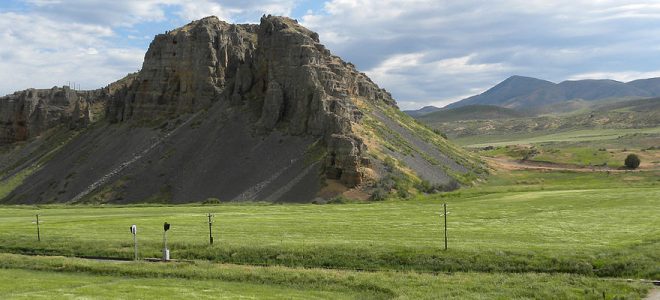

Monica Hubbard is an Assistant Professor in the School of Public Policy at Boise State University. Her research interests include water policy and management, risk perception, rangeland management, and emerging contaminants. Dr. Hubbard earned her PhD in Environmental Science, and Masters of Water Resources from Oregon State University.
The Mountain West is experiencing a population boom since the 2000 millennium. Idaho is no different – its population grew 26% between the years 2000 – 2014. Nowhere was this more evident than in Idaho’s metropolitan counties, including Ada, Bannock, and Canyon; which grew a respective 42%, 10% and 55% over the same period. Although this growth creates opportunities for Idahoans, it comes with change – often at the cost of productive agriculture land, and the alteration of the social, economic, and physical landscape.
The loss of farmland for non-agriculture use is nothing new. Throughout the United States, acreage of productive farmland has been in steady decline since the late 1970s. While some of this land is held in conservation or wetland reserves, much falls prey to parcelization and development in the form of urbanization and exurbanization. Urbanization is the expansion of low and high-density housing, industry, and infrastructure along the fringes of existing urban areas. Exurbanization, while similar, is fragmented growth, often in the form of isolated large-lot housing developments well beyond the urban fringe and near natural amenities. Due to its nature, this fragmented, “leap frog” growth is a concern for rural communities. Patchwork development between agricultural uses leads to complaints and conflict that increases pressure on remaining farmlands to cease production and develop. As the population increases, the loss of farmland is expected to continue. Land use economists project the development and urbanization in the lower 48 states’ surface area will increase from 5.2% in 1997 to 9.2% by 2025. This development would represent an area equal to 38% of the U.S. cropland base for the year 2000.

IMPACTS OF GROWTH
The changing landscape associated with growth comes with benefits and challenges for farmers. Proximity to urban centers can provide improved education, off-farm employment opportunities, increased access to farm labor, and expanded opportunities to market high-value crops. However, there are downsides. Urban expansion and fragmentation can have socio-economic, and ecological consequences, particularly for rural communities. Rising land values can lead to shifts in wealth and new class divisions. A rural community’s economic backbone is often agricultural production; as production shrinks, secondary agricultural industries, such as processing and sales, are impacted.
With urban expansion, open space and farmland are lost or sub-divided, thereby changing ecological conditions. Development, especially exurbanized development, has devastating impacts on flood control, wildlife, birds, aquatic species, vegetation, air and water quality, and water use. Wetlands are especially an area of great concern. Known as “biological supermarkets,” wetlands are among the most productive ecosystems in the world, and urban development is listed as the primary cause for their loss. Irrigated farmland, in particular water applied through flood and furrow irrigation methods, artificially recharges groundwater. Loss of this recharge can impact community groundwater drinking supplies.
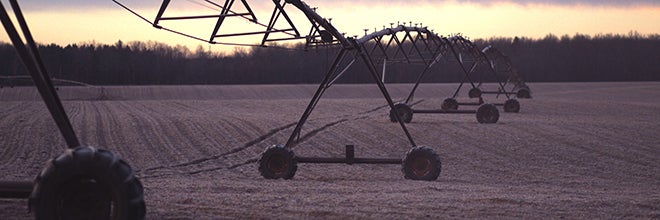
LOSS OF FARMLAND – IS IT JUST ABOUT THE MONEY?
Why are the number of farms shrinking, and with them the acres of farmland? Population growth and economic factors are considered key drivers to this land use change. But are there non-economic factors which lead farmers to exit and thus sell their land? Previous research suggests yes there are. These factors include age of the farmer; if there is a willing heir to take over the operation; access to capital; level of support from policy makers; impacts of patchwork development on farming operations; and the intrinsic rewards with farming, such as working outside.
WHAT ABOUT IDAHO?
Decline was particularly pronounced in Ada County, which witnessed a 36% loss of acres farmed and a 13% loss of agriculture operations over ten years.These are national trends, but what about Idaho? At an estimated $20.6 billion in sales in 2014, Idaho’s agribusiness is a key component of the economy. Using population as a measure, Idaho is a small state, but a state that is projected to grow at a rate of 1.4% annually through 2025. Currently about 40% of Idahoans call Ada and Canyon counties home, making it the most populous area in the state. In 2002, the two counties supported 495,380 acres of farmland and 3,635 farms. Ten years later these figures dropped to 447,885 acres and 3,564 farms. Decline was particularly pronounced in Ada County, which witnessed a 36% loss of acres farmed and a 13% loss of agriculture operations over ten years. One only needs to drive along Interstate-84 to see how this population density changed the landscape. Like Canyon and Ada Counties, Bannock County is not immune to farm loss; over the same period it experienced a 17% decline in the number of acres farmed and a 20% decrease in farm operations. As with the national trends, the farmland value in the three counties jumped in the same ten-year period: Ada increased 152%, Bannock 253% and Canyon 126%.
PROJECTING THE FUTURE: A CASE STUDY OF THREE IDAHO COUNTIES
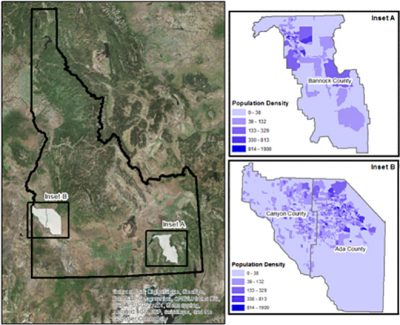
These trends lead to questions about the future. How will Idaho’s projected growth impact the landscape? Are Idaho’s farmers planning to sell their land? If so, what do they plan to do with it? What are the key factors influencing their decision? Will they follow the notion that it is all about the mighty dollar, or are there other reasons? To answer these and other relevant questions researchers from Boise State University, Idaho State University, and University of Idaho conducted a survey of agriculture land owners and operators in the three Idaho metropolitan counties of Ada, Bannock, and Canyon (Figure 1).
The survey results suggest the three counties are ripe for a land use transition (Figure 2). Of the 718 valid survey responses, 458 were landowners. Of these landowners, the mean age was 63 years old, only three years shy of the social security full retirement age. At a median of 42 years, many are long-time community members. With farmland value increasing and farmers close to retirement age, one would expect the majority of respondents plan to sell in the near future. And yet, this is not the case. In fact, when asked if they planned to sell some or all of their land by the year 2025 only 22% said yes. When asked why these individuals planned to sell, 71% stated it was due to retirement, far more than the 20% who plan to capitalize on the market. Of interest are the 7% selected who “other” as the reason for selling – the two key reasons they provided were the need to pay off debt and to pay off outstanding taxes.
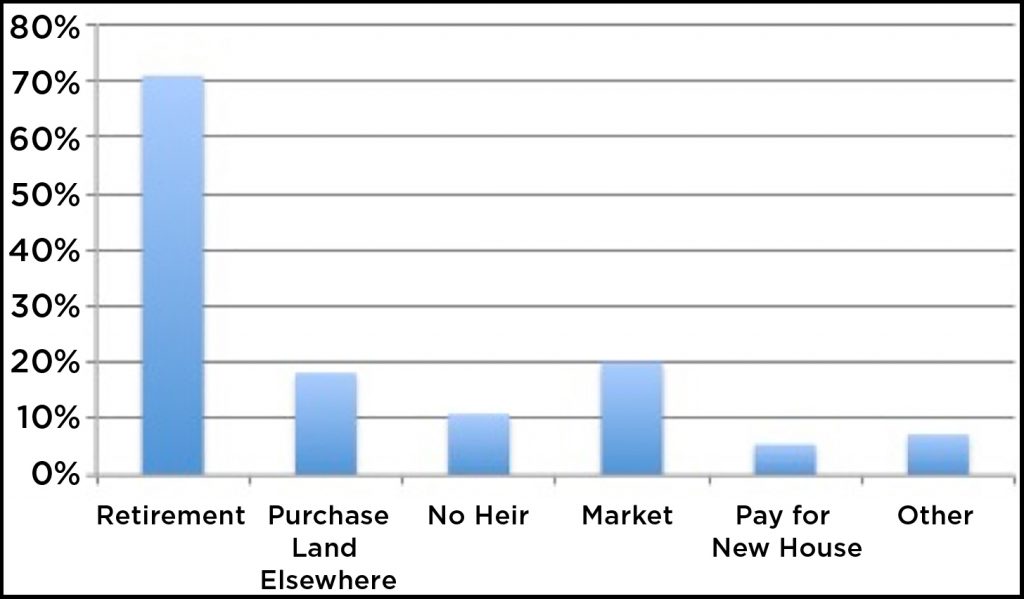
The survey then asked all the landowners to forecast what they plan to do with the land once they exit farming (Figure 3). Of these, 37% plan to sell their land on the market. A large proportion plan to keep the land with their family either by selling or gifting it. While another 13% plan to place it in a trust. A trust is frequently created for a family member, often the spouse of the primary operator, to live on the land’s profits.
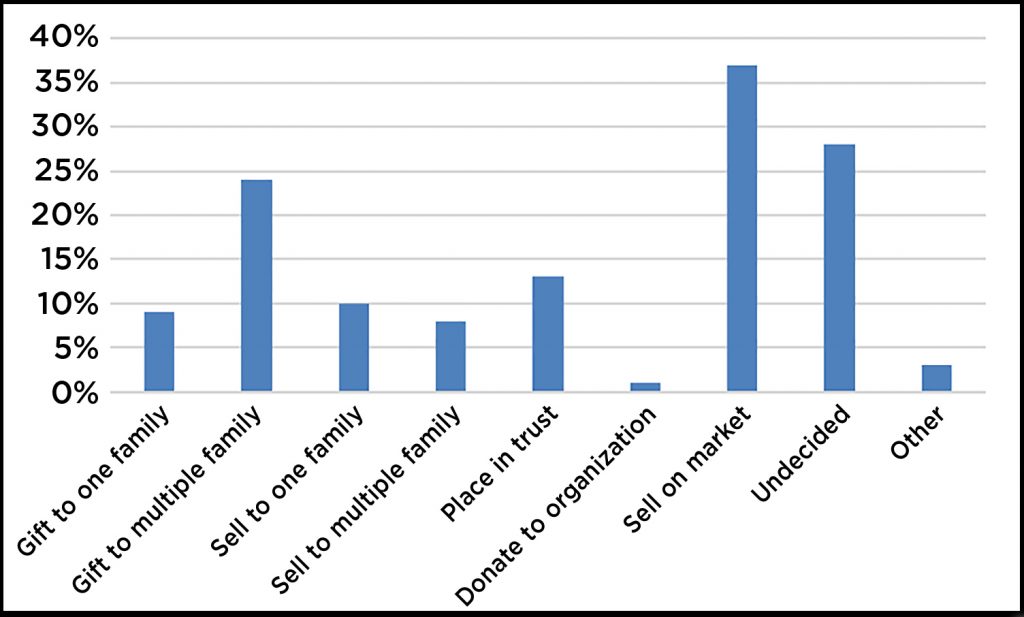
At first glance of the survey data, it appears the three Idaho counties may avoid rapid urbanization in the near future. After all, only 22% stated they plan to exit farming, and many of those plan to transfer it to family. Perhaps, but the devil is in the details. For one, only 44% of the respondents stated it is important that their farmland remains in agricultural production. Then there is the issue of the respondents’ age; the thing is, farmers are often unwilling or unable to retire. One reason is the sheer enjoyment of their occupation. In fact, the majority of the landowners surveyed stated they are satisfied with farming. Another reason is financial. Some farmers don’t make off-farm investments for retirement, but rather treat the farm as the source of retirement income. Considering the fact between 2002-2012 the net farm income in the three counties increased between 137% to 209%, evidence suggests many farmers can indeed use their operations’ profits to fund their retirement.
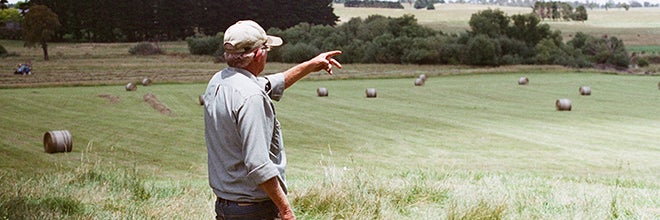
What about the family? The data suggests a large proportion of the landowners plan to transfer the land to their family, either by selling, gifting, or in a trust. This, however, leads to another question: what happens to the land after it is passed down? When farms are inherited by multiple family members, the original farmland parcel often does not survive intact. Known as parcelization, the farm ownership is split across all heirs, often compromising the farm’s ability to be profitable. As a result, these parcels are often sold on the market. Due to the challenge of getting the necessary capital to purchase the family farm, even farms sold to a single-family member may not stay intact.
CONCLUDING THOUGHTS
The goal of this research is to assess the potential land use changes in three Idaho metropolitan counties. Although Idaho is its own independent state, the survey results and previous research implicates the study area will follow national trends of development. However, the data suggests most landowners surveyed are not subject to the lure of the market, but prefer to use the farm as retirement. Perhaps the life of the family farm is correlated with the life of the farmer. If this is the case, policy makers can still take measures to protect Idaho’s farms and their associated benefits.